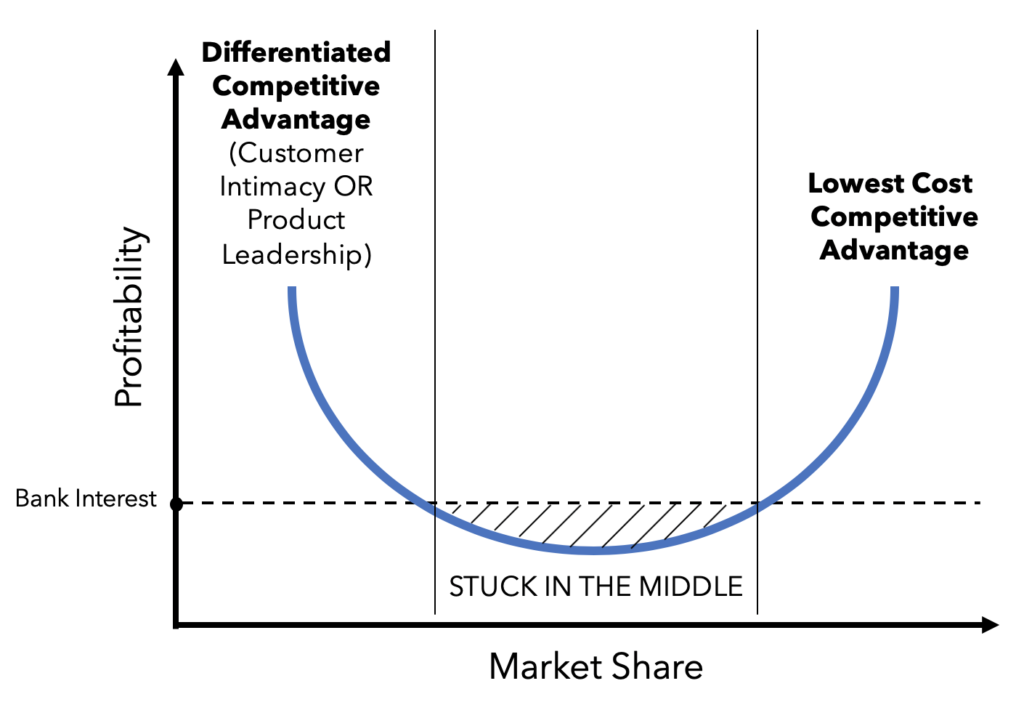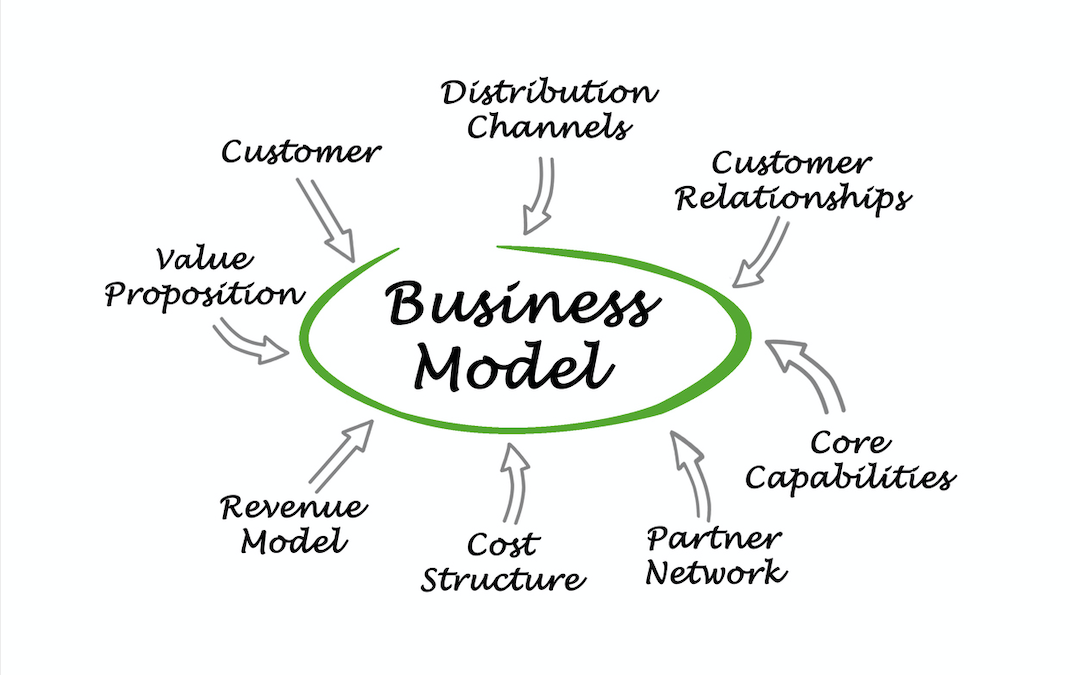At the top of the 1-page Strategic Plan is your long-term VISION. If you get this right, your business model will be up to date.
Your VISION should describe as precisely as possible what you and your Management Team collectively agree is the company’s customer-focused “Winning Aspiration” as defined in the book PLAYING TO WIN by Lafley and Martin. The time-frame for your VISION should be at least twice as long as your strategic planning time-frame.
Formulation of your Vision (or Winning Aspiration) is given considerable attention in the early part of the 2-day Foundation Planning Workshop because your Vision will drive the choices for every one of your strategic Objectives.
However, as a pre-cursor to finalizing your Vision through the PLAYING TO WIN methodology, we recommend that your Management Team should address several key issues prompted by the diagram below. This diagram combines the acclaimed research findings of Professor Michael Porter regarding the two fundamental options for sustainable competitive advantage (i.e., Differentiated versus Lowest Cost) and the two subset options for Differentiation espoused by Michael Treacy and Fred Wiersma, namely Customer Intimacy OR Product Leadership.

The danger of being STUCK IN THE MIDDLE if you don’t have a clear Competitive Advantage
According to Porter, Cost Leadership and Differentiation are such fundamentally contradictory strategies, that any business attempting to combine them would end up being “stuck in the middle” and hence fail to enjoy superior profitability.
Cost Leadership requires standardized products or services with few unique or distinctive features, so that costs are kept to an absolute minimum.
On the other hand, Differentiation usually depends on offering customers unique benefits and features, which almost always increase production and marketing costs. The products or services on offer are priced accordingly so that good margins are realized.
“A business ‘stuck in the middle’ either loses the high-volume customers who demand low prices or must bid away its profits to get this business away from low-cost firms. Yet it also loses high-margin businesses—the cream—to the firms who are focused on high-margin targets or have achieved differentiation overall. The firm stuck in the middle also probably suffers from a blurred corporate culture and a conflicting set of organizational arrangements and motivation system.”
Michael E Porter
There is no sustainable competitive advantage for a company that is stuck in the middle.
We believe that very few SMEs / SMBs can win with the Cost Leadership strategy. One of the main reasons for this is that they generally lack the necessary economies of scale, and hence leave themselves open to attack by a larger competitor that can undercut the company’s prices for the same type of goods or services. This leaves only the Differentiation option for most SMEs / SMBs.
And according to Treacy and Wiersma28, there are only two options within Porter’s Differentiation option for sustainable competitive advantage. Their main premise is that a business must choose—and then achieve—market leadership in either Customer Intimacy or Product Leadership. They argue that a business must achieve market leadership for one of these competitive advantages and perform adequately for the other one at reasonable cost.
The Customer Intimacy strategy focuses on offering a unique range of customer goods or services that allows for the personalization of service and the customization of products to meet differing customer needs. Often, businesses that pursue this strategy bundle their products and services into a “solution” tailored to suit a specific customer. These businesses must be quick to learn about emerging customer needs and quick to find ways of satisfying them. In other words, they must become Agile.
Amazon and Salesforce are well known large company examples of Customer Intimacy.
The Product Leadership strategy aims to build a culture that continually brings superior products to market. These businesses achieve premium market prices due to the superior experience they create for their customers. Product Leaders recognize that excellence in creativity, problem-solving, and teamwork is critical to their success.
The disciplines they develop include:
- Research into emerging customer needs
- Teamwork
- Product management
- Marketing
- Talent management
- Knowledge management
Apple, Nike and Rolex are well known large company examples of Product Leadership.
So, how does all this help you formulate your VISION? During the 2-day Foundation Planning Workshop conducted within the first few weeks of your implementation, your Management Team (including you) should address these fundamental questions:
- Where does your business currently sit on the curve of Figure 22?
- Does your business have any chance of becoming and remaining the Lowest Cost producer of its offerings in the future?
- If you believe your competitive advantage will be in Differentiation, will it be in terms of Customer Intimacy OR Product Leadership?
- If Customer Intimacy, what would this require of the business in relation to your future customers over the long term?
- If Product Leadership, what would this require of your future offerings over the long term?
If you choose Customer Intimacy, check out these key points for your consideration prior to attending the Workshop (Ref: Mind Tools, Customer Intimacy – Providing Lifetime Value To Your Customers, viewed 21 November 2019, <https://www.mindtools.com/pages/article/customer-intimacy.htm>…
“Customer intimacy is a highly customer-centric strategy, in which an organization strives to build a lasting personal relationship with its customers, by continually customizing its offerings to meet their exact needs and wants.
It can be a risky, high-cost strategy, as it requires a whole organization to buy into putting the customer’s experience before the bottom line. It also focuses a lot of time, attention and resources on individual customers, or on small segments of a market.
You can take four steps to develop customer intimacy: empower your team members, use data effectively, narrow your customer focus, and explore outside partnerships.
It’s essential to have a corporate structure that allows you to collect, analyze and act on data. The ability to understand or anticipate your customers’ needs will encourage them to forge a long-term relationship with you, because of your dedication and unique ability in meeting those needs.”
Based on the responses, your Management Team can now formulate your brief, long-term VISION. In stark contrast to your clinical ROLE statement at the top of your 1-page Process Model, your resultant VISION should be as emotional as possible. It should encapsulate your Winning Aspiration—and be the reason why you and your people are keen to come to work every day. Being an emotional concept, it is of course, part of Leadership.
Incidentally, there is no set format for your VISION, but it must be brief so that your people find it easy to remember. And it should be unique to your business and NOT repeat elements of your ROLE statement which you already will have at the top of your 1-page Process Model.
It might help if you start your VISION with “To…,” and the words that follow should be such that everybody in your organization can sense at any time in the future that the business has made real progress towards its achievement.
Here are a few generic examples as thought starters:
- “To be uppermost in the minds of Millennials when buying a product in our market”
- “To leverage our scale and become the lowest cost producer”
- “To have more current patents than anybody else in our targeted markets”
- “To have the highest customer satisfaction ratings for customized offerings in our chosen segments”
- “To engage and retain the most creative people involved in industrial design”

